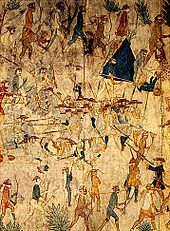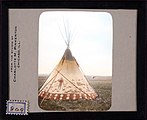Plains hide painting

Plains hide painting is a traditional North American
Genres
Art historian Joyce Szabo writes that Plains artists were concerned "with composition, balance, symmetry, and variety."[1] Designs can be similar to those found in earlier rock art and later quillwork and beadwork.
Geometric painting

Plains women traditionally paint abstract, geometric designs.
Buffalo robes and parfleches were frequently painted with geometrical patterns. Parfleches are rawhide envelopes for carrying and storing goods, including food. Their painted designs are thought to be stylized maps, featuring highly abstract geographic features such as rivers or mountains.[4]
The "Feathered Sun" is a reoccurring motif of stylized feathers in several concentric circles. It visually connects a feather warbonnet to the sun.[5]
Representational painting

Traditionally, men painted representational art.
Heraldic painting
Men recorded their battle and hunting exploits on hide tipi liners, robes, and even shirts.
Painted hides also commemorate historical events, such as treaty signings.
After 1850, hide painting grew in complexity with finer lines and additional details added.
Calendars

Traditional Plains calendars are called winter counts because among most Plains tribes they feature a single pictogram that defined the entire year. Prior to using the Gregorian calendar, Lakota people counted years from first snow to first snow. Kiowas were unique in choosing two images per year– one for the winter and one representing the summer Sun Dance.[14]
Before the late 19th century when buffalo became scarce, winter counts were painted in buffalo hides. The annual pictograms could be arranged in a linear, spiral, or serpentine pattern.[15]
Visionary painting
Visions and dreams could inspire designs.
Followers of the
Process and materials
Buffalo hides, as well as deer, elk, and other animal hides, are painted. Clothing and robes are often brain-tanned to be soft and supple. Parfleches, shields, and moccasin soles are rawhide for toughness.
In the past, Plains artists used a bone or wood
In earlier times, all members of a tribe might paint but highly skilled individuals might be commissioned by others to create artwork.[17] Before the 20th century, when a Kiowa man needed to repaint his lodge, he would invite 20-30 friends to paint the entire tipi in a single day. He would then treat them all to a feast.[6]
Related art forms
Many tribes throughout North America, besides those on the Plains, also painted hides, following different aesthetic traditions. Subarctic tribes are known for their painted caribou hides. On the Plains, when buffalo herds were being slaughtered in the late 19th century, other painting surfaces became available, such as muslin, paper, and canvas, giving birth to Ledger art.[21] Contemporary Plains beadwork and jewelry used designs from hide painting.[22]
Gallery
-
Knife River Villages buffalo robe featuring the "Feathered Sun" motif, photo by Chris Light
-
Sioux beaded and painted rawhide parfleches
-
Siksika war tipi, Montana, by McClintock
-
Siksika rainbow tipi, Montana, by McClintock
-
Contemporary painted rawhide hand drums, National Museum of the American Indian
-
 Elk hide painting by Eastern Shoshone artist Cotsiogo.
Elk hide painting by Eastern Shoshone artist Cotsiogo.
Notable Plains hide painters
- Oglala Lakota
- Naiche, Chiricahua Plains Apache
- Silver Horn, Kiowa
- Tohausen, Kiowa
See also
- Native American art
- Painting in the Americas before Colonization
- American Bison Society
- Bison bison)
- Bison hunting
- Bison
- Buffalo Commons
- Buffalo Hunters' War
- European bison
- Great bison belt
- Wind Cave Bison Herd
- Wisent
- Wood bison
- Yellowstone Park Bison Herd
Notes
- ^ Szabo, 4
- ^ a b c d Szabo, 5
- ^ a b "More About Buffalo Hide Painting." National Museum of American History. (retrieved 4 Feb 2010)
- ^ Goes in Center, John. "Native American and First Nations' GIS." Native Geography. 2000 (retrieved 4 Feb 2010)
- ^ Dubin, 236-7
- ^ a b c Szabo, 7
- ^ Szabo, 5, 7
- ^ Szabo, 10
- ^ Szabo, 31
- ^ Szabo, 32
- ^ Penney, 114
- ^ "Buffalo Robe." British Museum. (retrieved 4 Feb 2010)
- ^ a b Szabo, 12
- ^ Szabo, 7-8
- ^ Szabo, 8
- ^ a b Penney, 112
- ^ a b c Szabo, 6
- ^ Penney, 124
- ^ Szabo, 13
- ^ Dubin, 246
- ^ Szabo, 16
- ^ Dubin, 263
References
- Dubin, Lois Sherr. North American Indian Jewelry and Adornment: From Prehistory to the Present. New York: Harry N. Abrams, 1999. ISBN 0-8109-3689-5.
- Penney, David W. North American Indian Art. London: Thames & Hudson, 2004. ISBN 0-500-20377-6.
- Szabo, Joyce M. Howling Wolf and the History of Ledger Art. Albuquerque: University of New Mexico Press, 1984. ISBN 0-8263-1467-8.
External links
- Plains Art, Glenbow Museum
- Tracking the Buffalo: Stories from a Buffalo Hide Painting, National Museum of American History (for children)
- Native paths: American Indian art from the collection of Charles and Valerie Diker, an exhibition catalog from The Metropolitan Museum of Art (fully available online as PDF), which contains material on Plains hide painting






